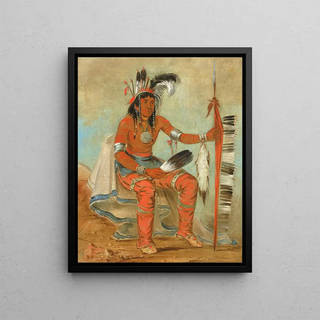Art print | Ondaig the Crow, a dandy - George Catlin


View from behind

Frame (optional)
In the fascinating world of art, some works transcend the simple frame to become living witnesses of history and culture. "Ondaig the Crow, a dandy - George Catlin" is one of those creations that capture the essence of an era while offering a window into the lives of Indigenous peoples of America. This iconic piece, created by George Catlin in the 19th century, is part of a broader project documenting Native American tribes, highlighting their cultural richness and way of life. Through this art print, viewers are invited to immerse themselves in a universe where refinement and tradition meet, revealing the nuances of a often little-known identity.
Style and uniqueness of the work
George Catlin's style is distinguished by his ability to blend realism with poetic sensitivity. In "Ondaig the Crow, a dandy," the artist manages to capture not only the physical features of his subject but also the aura surrounding him. The vivid colors and meticulous details of traditional clothing reflect a deep respect for the culture of the peoples he depicts. Facial expressions and the posture of the character reveal a complex personality, oscillating between pride and melancholy. Catlin, a true visual storyteller, succeeds in conveying a story through each brushstroke, making the work both lively and timeless. The harmony between figurative elements and the pictorial background creates an immersive atmosphere, inviting the viewer to feel the spirit and energy of the scene.
The artist and his influence
George Catlin, born in 1796, is often regarded as one of the pioneers of American genre painting. His work is marked by a profound commitment to representing Native American cultures, at a time when they were threatened by colonial expansion. Catlin traveled across the United States, meeting and painting members of different tribes, which allowed him to compile a vast collection of works reflecting the diversity and richness of indigenous traditions. His influence extends beyond his era, inspiring

Matte finish

View from behind

Frame (optional)
In the fascinating world of art, some works transcend the simple frame to become living witnesses of history and culture. "Ondaig the Crow, a dandy - George Catlin" is one of those creations that capture the essence of an era while offering a window into the lives of Indigenous peoples of America. This iconic piece, created by George Catlin in the 19th century, is part of a broader project documenting Native American tribes, highlighting their cultural richness and way of life. Through this art print, viewers are invited to immerse themselves in a universe where refinement and tradition meet, revealing the nuances of a often little-known identity.
Style and uniqueness of the work
George Catlin's style is distinguished by his ability to blend realism with poetic sensitivity. In "Ondaig the Crow, a dandy," the artist manages to capture not only the physical features of his subject but also the aura surrounding him. The vivid colors and meticulous details of traditional clothing reflect a deep respect for the culture of the peoples he depicts. Facial expressions and the posture of the character reveal a complex personality, oscillating between pride and melancholy. Catlin, a true visual storyteller, succeeds in conveying a story through each brushstroke, making the work both lively and timeless. The harmony between figurative elements and the pictorial background creates an immersive atmosphere, inviting the viewer to feel the spirit and energy of the scene.
The artist and his influence
George Catlin, born in 1796, is often regarded as one of the pioneers of American genre painting. His work is marked by a profound commitment to representing Native American cultures, at a time when they were threatened by colonial expansion. Catlin traveled across the United States, meeting and painting members of different tribes, which allowed him to compile a vast collection of works reflecting the diversity and richness of indigenous traditions. His influence extends beyond his era, inspiring






